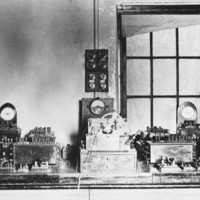Subject
ContributeThe first Australian telegraph line, built in 1853–54 from Melbourne to Williamstown, demonstrated the power of this technology to speed commercial transactions. Telegrams, the e‑mail of the day, soon yielded significant revenue, a fact not lost on the administration in Adelaide.
The South Australian government asked the Colonial Office to find an astronomer with telegraphy knowledge to head its own version of Victoria’s initiative. The appointment of Charles Todd early in 1855 as Superintendent of Telegraphs and Astronomical Observer predated the inauguration of responsible government in the colony by almost a year, illustrating the importance placed on securing the nascent technology as a government monopoly.
Todd’s arrival from London in November 1855 with his new wife, Alice, technical assistant Edward Cracknell and a quantity of equipment coincided with the completion of a private telegraph line from Adelaide to Port Adelaide. Rising to the challenge, Todd pushed ahead with the first government line and linked the same points on 18 February 1856. Unlike its short-lived competitor, Todd’s line was a success, as was his decision to train local operators rather than bring telegraphists with him as instructed.
Other lines, to Gawler to the north of Adelaide and Port Elliot and Goolwa on Fleurieu Peninsula were opened in 1857. More importantly, Todd had already journeyed to Melbourne and successfully negotiated to establish the first intercolonial link. Todd surveyed the route for the South Australian section on his way home, and the line was completed in July 1858. Sydney and Adelaide were directly joined by 1867. When a 1255-kilometre line to Eucla finally connected Western Australia to its sister colonies in 1877, Port Adelaide was no longer the first available telegraph stop for overseas shipping, reducing the swarms of journalists who had competed among themselves to telegraph the latest news to their editors.
Technical problems with submarine cables were solved by 1870, when the South Australian government outbid Queensland in complex negotiations with the British and Australian Telegraph Co. A bill was rushed through parliament securing the prized land connection for a proposed link with London. Against extraordinary odds, the Overland Telegraph Line (OTL) from Adelaide to Darwin was completed on 22 August 1872. This single strand of galvanised wire had cost the lives of five workers, but now crossed the continent over country largely unknown to white settlers.
Secrecy was always a prime requirement of telegraphists, and once overseas cables began to flow companies quickly introduced business codes to thwart competitors. During wartime the telegram boy on the red bicycle became the harbinger of bad news for unlucky families with loved ones in the services. In happier times, birthdays, weddings and anniversaries were celebrated by special greetings telegrams. At wedding receptions it was obligatory for the best man to read out risqué telegrams of advice for the newly-weds.
The heavy and lucrative volume of traffic over the network soon led to the introduction of improved equipment and the multiplication of lines. By 1880 there was a more reliable inland line to Melbourne, via Murray Bridge and Bordertown, and within a decade copper began to replace the original galvanised wire. In 1897 Todd introduced a more efficient ‘universal telegraph code’ that continued in use until the last signals were tapped out from Adelaide to Kalangadoo in April 1963. ‘The most perfect invention’ (Melbourne Argus, 15 June 1853), and its skilled operatives had been superseded; automatic telegraphy and telephony now held sway. A small group of ex-operatives have preserved the old skills and celebrate the anniversary of the OTL each year by tapping out messages to colleagues via a temporary hookup to Darwin.
Media
Add mediaImages

Image courtesy of the State Library of South Australia, SLSA: PRG 1365/1/133, Public Domain

Image courtesy of the State Library of South Australia, SLSA: PRG 1365/1/103, Public Domain

Image courtesy of the State Library of South Australia, SLSA: B 62545, Public Domain

Image courtesy of the State Library of South Australia, SLSA: PRG 280/1/1/44, Public Domain

Image courtesy of the State Library of South Australia, SLSA: B 9279, Public Domain

Image courtesy of the State Library of South Australia, SLSA: B 69996/15, Public Domain

Image courtesy of the State Library of South Australia, SLSA: PRG 280/1/28/293, Public Domain

Image courtesy of the State Library of South Australia, SLSA: PRG 1218/34/827c, Public Domain



CommentAdd new comment
Quickly, it's still quiet here; be the first to have your say!